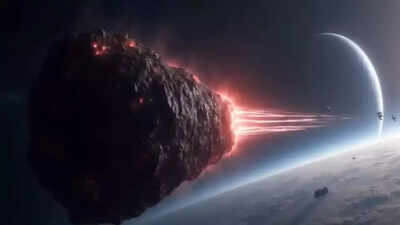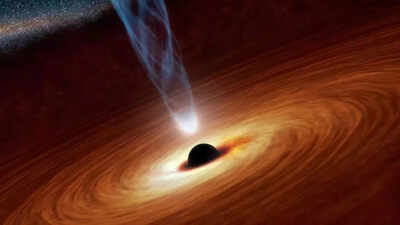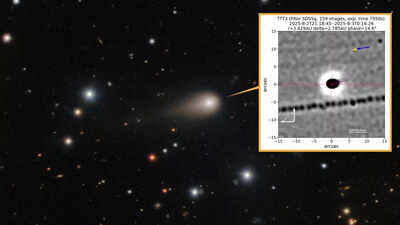3I ATLAS might expose the universe’s greatest mystery by October 30 and it could finally prove ‘we’re not alone’ |

Does alien life truly exist? This question has always fascinated humans for varied centuries whether there is alien life existing or it’s just the matter of unusual cosmic mystery. But now, according to the renowned theoretical physicist Dr Michio Kaku, the cosmic mystery may ends soon. According to the prediction, by 29 or 30 October 2025, astronomers could determine the 3I/ATLAS, an interstellar object is a natural fragment of space debris or just the creation of design.In modern science, this potential revelation could represent one of the most significant discoveries offering the real test of whether other advanced civilisations may exist within the galaxy or not.
Michio Kaku’s prediction on 3I/ATLAS and the growing debate
Dr Michio Kaku, professor at the City College of New York and author of Quantum Supremacy, has earned a reputation for exploring the boundaries between science and speculation. In a recent television interview, he explained that the astronomical community is sharply divided about what 3I/ATLAS truly is.According to Kaku, most scientists believe the object is another interstellar rock, similar to those occasionally passing through our Solar System. However, a smaller but increasingly vocal group of researchers believe the object could be artificial or guided by some form of advanced intelligence.“The majority believe it’s just another rock from deep space—the third interstellar object we’ve ever recorded,” said Kaku. “But a growing number suspect it may be something more—perhaps an intelligent visitor.” This divide highlights the increasing curiosity and unease surrounding 3I/ATLAS.
3I/ATLAS’s close encounter with the Sun
The object, estimated to be roughly the size of Manhattan, is expected to make its closest approach to the Sun, known as perihelion, on 29 or 30 October 2025. This moment is critical for astronomers, as it will allow them to test whether 3I/ATLAS follows predictable orbital mechanics or behaves in a way that challenges the known laws of physics.If it gains more energy than expected while moving around the Sun, that could suggest that something, possibly even an intelligent mechanism, is controlling it. Kaku explained, “If it picks up extra energy as it whips around the Sun, that would be outside the ordinary bounds of conservation of energy. That would mean, in no uncertain terms, that some intelligence is guiding it.”In other words, if 3I/ATLAS accelerates beyond what gravity alone can explain, it might be the first sign of a technology or propulsion system not made by humans.
Discovery and observations of 3I/ATLAS
3I/ATLAS was first discovered on 1 July 2025 by the ATLAS telescope system in Hawaii. It was quickly classified as an interstellar object because its hyperbolic trajectory indicated that it is not gravitationally bound to our Solar System. In simple terms, it came from another star system and is just passing through ours.The object is expected to pass closest to the Sun at about 1.4 astronomical units (AU) and make its nearest approach to Earth on 19 December 2025, at around 1.8 AU, or roughly 270 million kilometres away. Since its discovery, NASA has been quietly tracking 3I/ATLAS, noting several unusual features. Its energy readings and movements do not completely match the behaviour of typical comets or asteroids. Although NASA has not released detailed findings, it continues to monitor the object closely, updating its orbital data daily.
Why scientists are comparing it to ‘Oumuamua
The growing excitement around 3I/ATLAS is reminiscent of the scientific reaction to ‘Oumuamua, another interstellar object discovered in 2017. That object, with its strange cigar-like shape and unexplainable acceleration, baffled astronomers. Harvard astrophysicist Avi Loeb famously proposed that ‘Oumuamua might have been a fragment of alien technology or even a defunct probe from an advanced civilisation.Dr Kaku’s comments about 3I/ATLAS have revived those debates. Many researchers believe it could provide new data that helps confirm or refute the theories first raised by Oumuamua’s mysterious journey. On social media, Kaku expressed his anticipation, saying:“3I/ATLAS is a mystery interstellar object noted for its hyperbolic path toward the Sun and very high speed relative to the Solar System. In mere days, #3IATLAS promises to yield new information—and perhaps new questions.”“I would bet that intelligent life exists throughout the galaxy, perhaps even in our own neighbourhood,” he said. “The real question is: can they reach us?”If the upcoming observations show any evidence of unusual acceleration or directed movement, it could mark the first tangible sign that another intelligent species has created technology capable of traversing the stars. Such a finding would redefine humanity’s place in the cosmos. The universe has long kept its secrets, but as 3I/ATLAS approaches the Sun, it may finally reveal whether we are truly alone or not.Also Read | Scientists call 3I/ATLAS a rare “Black Swan” object as astronomers watch its strange path and possible alien clues






